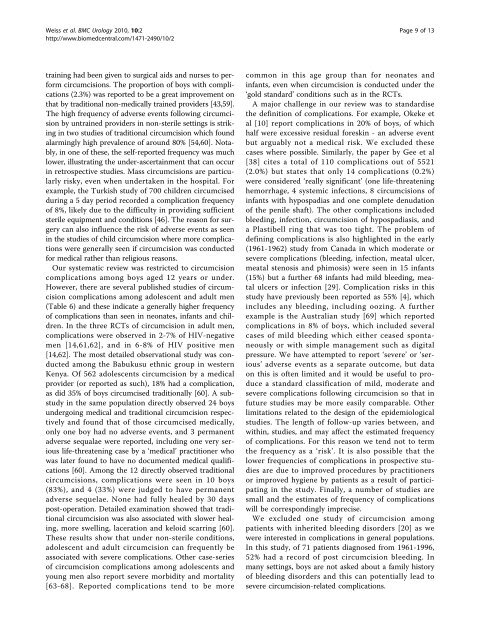Notat om omskæring af drenge - Sundhedsstyrelsen
Notat om omskæring af drenge - Sundhedsstyrelsen
Notat om omskæring af drenge - Sundhedsstyrelsen
- No tags were found...
Create successful ePaper yourself
Turn your PDF publications into a flip-book with our unique Google optimized e-Paper software.
Weiss et al. BMC Urology 2010, 10:2http://www.bi<strong>om</strong>edcentral.c<strong>om</strong>/1471-2490/10/2Page 9 of 13training had been given to surgical aids and nurses to performcircumcisions. The proportion of boys with c<strong>om</strong>plications(2.3%) was reported to be a great improvement onthat by traditional non-medically trained providers [43,59].The high frequency of adverse events following circumcisionby untrained providers in non-sterile settings is strikingin two studies of traditional circumcision which foundalarmingly high prevalence of around 80% [54,60]. Notably,in one of these, the self-reported frequency was muchlower, illustrating the under-ascertainment that can occurin retrospective studies. Mass circumcisions are particularlyrisky,evenwhenundertakeninthehospital.Forexample, the Turkish study of 700 children circumcisedduring a 5 day period recorded a c<strong>om</strong>plication frequencyof 8%, likely due to the difficulty in providing sufficientsterile equipment and conditions [46]. The reason for surgerycan also influence the risk of adverse events as seenin the studies of child circumcision where more c<strong>om</strong>plicationswere generally seen if circumcision was conductedfor medical rather than religious reasons.Our systematic review was restricted to circumcisionc<strong>om</strong>plications among boys aged 12 years or under.However, there are several published studies of circumcisionc<strong>om</strong>plications among adolescent and adult men(Table 6) and these indicate a generally higher frequencyof c<strong>om</strong>plications than seen in neonates, infants and children.In the three RCTs of circumcision in adult men,c<strong>om</strong>plications were observed in 2-7% of HIV-negativemen [14,61,62], and in 6-8% of HIV positive men[14,62]. The most detailed observational study was conductedamong the Babukusu ethnic group in westernKenya. Of 562 adolescents circumcision by a medicalprovider (or reported as such), 18% had a c<strong>om</strong>plication,as did 35% of boys circumcised traditionally [60]. A substudyin the same population directly observed 24 boysundergoing medical and traditional circumcision respectivelyand found that of those circumcised medically,only one boy had no adverse events, and 3 permanentadverse sequalae were reported, including one very seriouslife-threatening case by a ‘medical’ practitioner whowas later found to have no documented medical qualifications[60]. Among the 12 directly observed traditionalcircumcisions, c<strong>om</strong>plications were seen in 10 boys(83%), and 4 (33%) were judged to have permanentadverse sequelae. None had fully healed by 30 dayspost-operation. Detailed examination showed that traditionalcircumcision was also associated with slower healing,more swelling, laceration and keloid scarring [60].These results show that under non-sterile conditions,adolescent and adult circumcision can frequently beassociated with severe c<strong>om</strong>plications. Other case-seriesof circumcision c<strong>om</strong>plications among adolescents andyoung men also report severe morbidity and mortality[63-68]. Reported c<strong>om</strong>plications tend to be morec<strong>om</strong>mon in this age group than for neonates andinfants, even when circumcision is conducted under the‘gold standard’ conditions such as in the RCTs.A major challenge in our review was to standardisethe definition of c<strong>om</strong>plications. For example, Okeke etal [10] report c<strong>om</strong>plications in 20% of boys, of whichhalf were excessive residual foreskin - an adverse eventbut arguably not a medical risk. We excluded thesecases where possible. Similarly, the paper by Gee et al[38] cites a total of 110 c<strong>om</strong>plications out of 5521(2.0%) but states that only 14 c<strong>om</strong>plications (0.2%)were considered ‘really significant’ (one life-threateninghemorrhage, 4 systemic infections, 8 circumcisions ofinfants with hypospadias and one c<strong>om</strong>plete denudationof the penile sh<strong>af</strong>t). The other c<strong>om</strong>plications includedbleeding, infection, circumcision of hypospadiasis, anda Plastibell ring that was too tight. The problem ofdefining c<strong>om</strong>plications is also highlighted in the early(1961-1962) study fr<strong>om</strong> Canada in which moderate orsevere c<strong>om</strong>plications (bleeding, infection, meatal ulcer,meatal stenosis and phimosis) were seen in 15 infants(15%) but a further 68 infants had mild bleeding, meatalulcers or infection [29]. C<strong>om</strong>plication risks in thisstudy have previously been reported as 55% [4], whichincludes any bleeding, including oozing. A furtherexample is the Australian study [69] which reportedc<strong>om</strong>plications in 8% of boys, which included severalcases of mild bleeding which either ceased spontaneouslyor with simple management such as digitalpressure. We have attempted to report ‘severe’ or ‘serious’adverse events as a separate outc<strong>om</strong>e, but dataon this is often limited and it would be useful to producea standard classification of mild, moderate andsevere c<strong>om</strong>plications following circumcision so that infuture studies may be more easily c<strong>om</strong>parable. Otherlimitations related to the design of the epidemiologicalstudies. The length of follow-up varies between, andwithin, studies, and may <strong>af</strong>fect the estimated frequencyof c<strong>om</strong>plications. For this reason we tend not to termthe frequency as a ‘risk’. It is also possible that thelower frequencies of c<strong>om</strong>plications in prospective studiesare due to improved procedures by practitionersor improved hygiene by patients as a result of participatingin the study. Finally, a number of studies aresmall and the estimates of frequency of c<strong>om</strong>plicationswill be correspondingly imprecise.We excluded one study of circumcision amongpatients with inherited bleeding disorders [20] as wewere interested in c<strong>om</strong>plications in general populations.In this study, of 71 patients diagnosed fr<strong>om</strong> 1961-1996,52% had a record of post circumcision bleeding. Inmany settings, boys are not asked about a family historyof bleeding disorders and this can potentially lead tosevere circumcision-related c<strong>om</strong>plications.

















